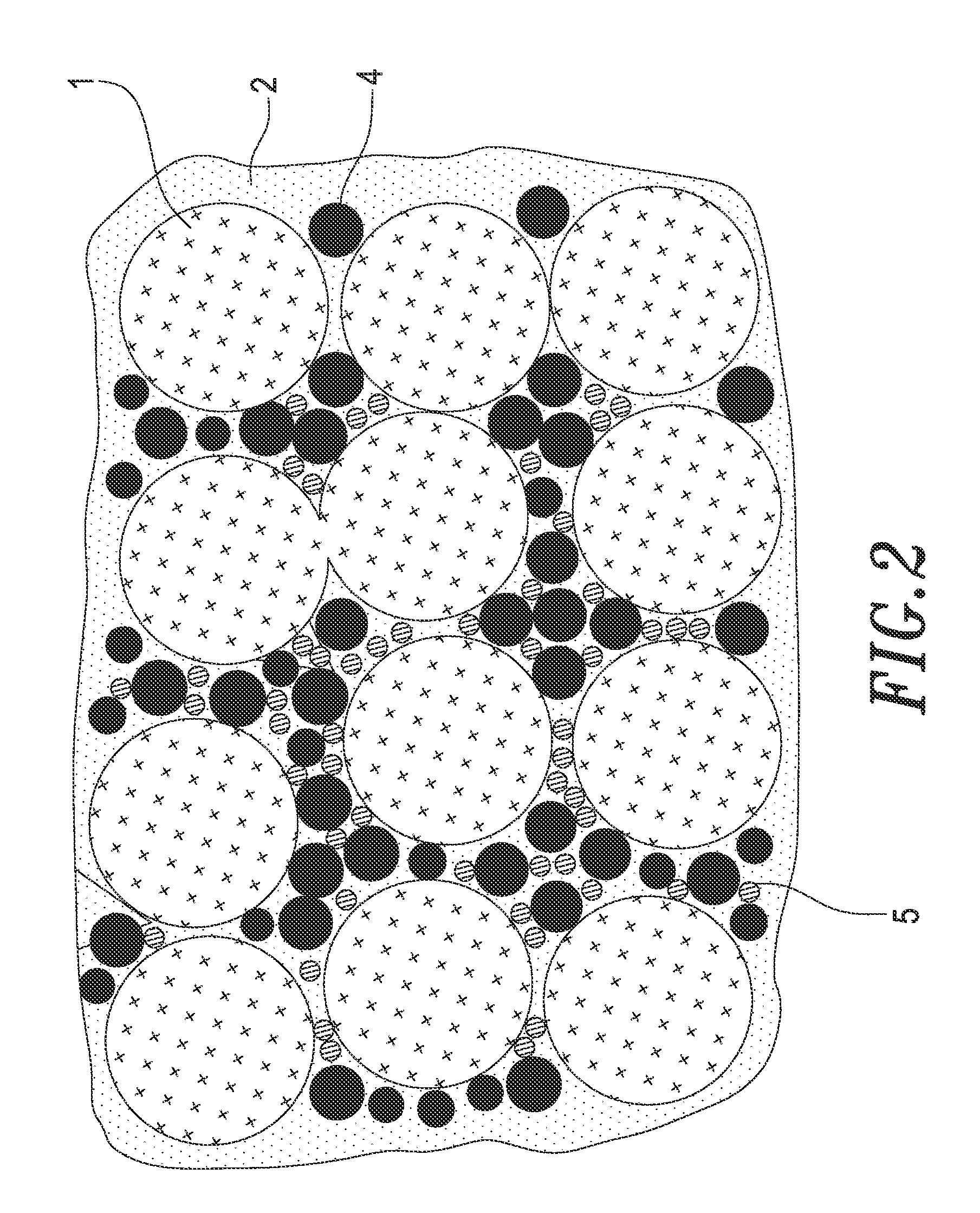Thermally conductive silicone composition
a silicone composition and thermally conductive technology, applied in the direction of solid balls, mixing, sports equipment, etc., can solve the problems of reducing the thermally conductive efficiency of the heat dissipating sheet, inevitably affecting the normal operation of the electronic appliance, etc., to achieve low manufacturing cost, low thermal impedance, and high mechanical strength
- Summary
- Abstract
- Description
- Claims
- Application Information
AI Technical Summary
Benefits of technology
Problems solved by technology
Method used
Image
Examples
examples 1 to 8
[0028]A liquid room-temperature vulcanized silicone having a specific gravity of 0.98 and a consistency of 100 (trade name is SC412, made by Hsin Han Electronic Co. Ltd., Taiwan) is used as the silicone. In the Examples 1 to 8, a proportion of such silicone to the thermally conductive silicone composite to be prepared is 40% by volume. Silicon carbide (SiC) particles having an average diameter of 18 millimeters (MODEL GC8000, manufactured by Titanex Corp., Taiwan) is used as the first heat conducting filler. Zinc oxide (ZnO) particles having an average diameter of 1 millimeter to 5 millimeters (manufactured by Pan-Continental Chemical Co., Ltd., Taiwan) is used as the second heat conducting filler. At room temperature, the mixture of the silicone, the first and second heat conducting fillers is blended well to form a thermally conductive silicone composition. In such fashion, eight thermally conductive silicone compositions can be prepared. The thermal conductivity of each of the th...
examples 9 to 13
[0031]The silicone and the first heat conducting filler of Examples 9 to 13 are similar to those of Examples 1 to 8, except that the second heat conducting filler and the proportion of the first and second heat conducting fillers. Copper oxide (CuO) particles having an average diameter of 5 millimeters (manufactured by Echo Chemical Co., Ltd., Taiwan) is used as the second heat conducting filler. The proportion of the first and second heat conducting fillers to the corresponding thermally conductive silicone composition to be prepared, and the thermal conductivity of each of the thermally conductive silicone compositions to be prepared are shown in Table 2.
[0032]
TABLE 2ThermalconductivityExamplesSiC (18 μm)CuO (5 μm)Cross-Link(W / m · K)950 vol %10 vol %—1.91040 vol %20 vol %—1.91130 vol %30 vol %—2.01220 vol %40 vol %—1.71310 vol %50 vol %—1.5
[0033]As can be seen from the data shown in Table 2, the thermally conductive silicone compositions prepared in Examples 9 to 13 have their the...
examples 14 to 18
[0034]The silicone and the first heat conducting filler of Examples 14 to 18 are similar to those of Examples 1 to 8, except that the second heat conducting filler and the proportion of the first and second heat conducting fillers. Iron oxide (Fe2O3) particles having an average diameter of 1 millimeter (manufactured by Echo Chemical Co., Ltd., Taiwan) is used as the second heat conducting filler. The proportion of the first and second heat conducting fillers to the corresponding thermally conductive silicone composition to be prepared, and the thermal conductivity of each of the thermally conductive silicone compositions to be prepared are shown in Table 3.
[0035]
TABLE 3ThermalconductivityExamplesSiC(18 μm)Fe2O3 (1 μm)Cross-Link(W / m · K)1450 vol %10 vol %—2.41540 vol %20 vol %—2.41630 vol %30 vol %—2.41720 vol %40 vol %—2.21810 vol %50 vol %—X
[0036]As can be seen from the data shown in Table 3, the thermally conductive silicone composition prepared in Examples 14 to 18 have their the...
PUM
| Property | Measurement | Unit |
|---|---|---|
| particle diameter | aaaaa | aaaaa |
| particle diameter | aaaaa | aaaaa |
| particle diameter | aaaaa | aaaaa |
Abstract
Description
Claims
Application Information
 Login to View More
Login to View More - R&D
- Intellectual Property
- Life Sciences
- Materials
- Tech Scout
- Unparalleled Data Quality
- Higher Quality Content
- 60% Fewer Hallucinations
Browse by: Latest US Patents, China's latest patents, Technical Efficacy Thesaurus, Application Domain, Technology Topic, Popular Technical Reports.
© 2025 PatSnap. All rights reserved.Legal|Privacy policy|Modern Slavery Act Transparency Statement|Sitemap|About US| Contact US: help@patsnap.com


